CX554101 Marketing Report: Starbucks Bubble Tea Strategy
VerifiedAdded on 2023/03/17
|26
|5141
|89
Report
AI Summary
This report provides a comprehensive marketing analysis for Starbucks' planned introduction of bubble tea in the New Zealand market. It begins with an executive summary and table of contents, followed by a detailed situational analysis that examines market size, trends, competitor analysis, and both internal and external environmental factors, including Porter's Five Forces and a PESTLE analysis. The report then delves into market segmentation, targeting the 21-60 age group, and product positioning, followed by the establishment of measurable marketing objectives. Marketing strategies are discussed, encompassing product, pricing, distribution, and promotional decisions, with recommendations for each. The report also outlines coordination and control methods for monitoring the success of the marketing initiatives, and concludes with a summary of the key findings and recommendations, supported by a list of references.
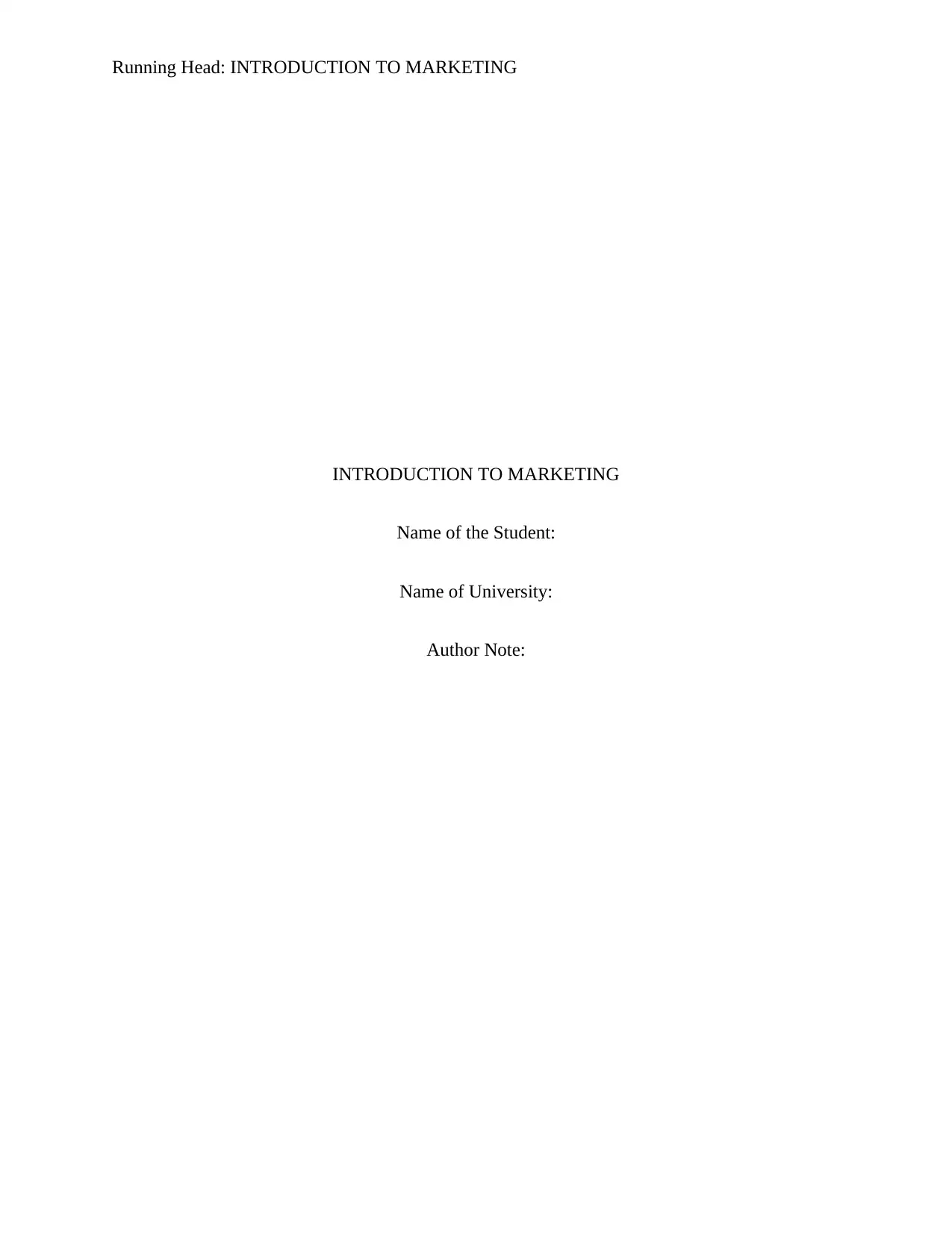
Running Head: INTRODUCTION TO MARKETING
INTRODUCTION TO MARKETING
Name of the Student:
Name of University:
Author Note:
INTRODUCTION TO MARKETING
Name of the Student:
Name of University:
Author Note:
Paraphrase This Document
Need a fresh take? Get an instant paraphrase of this document with our AI Paraphraser
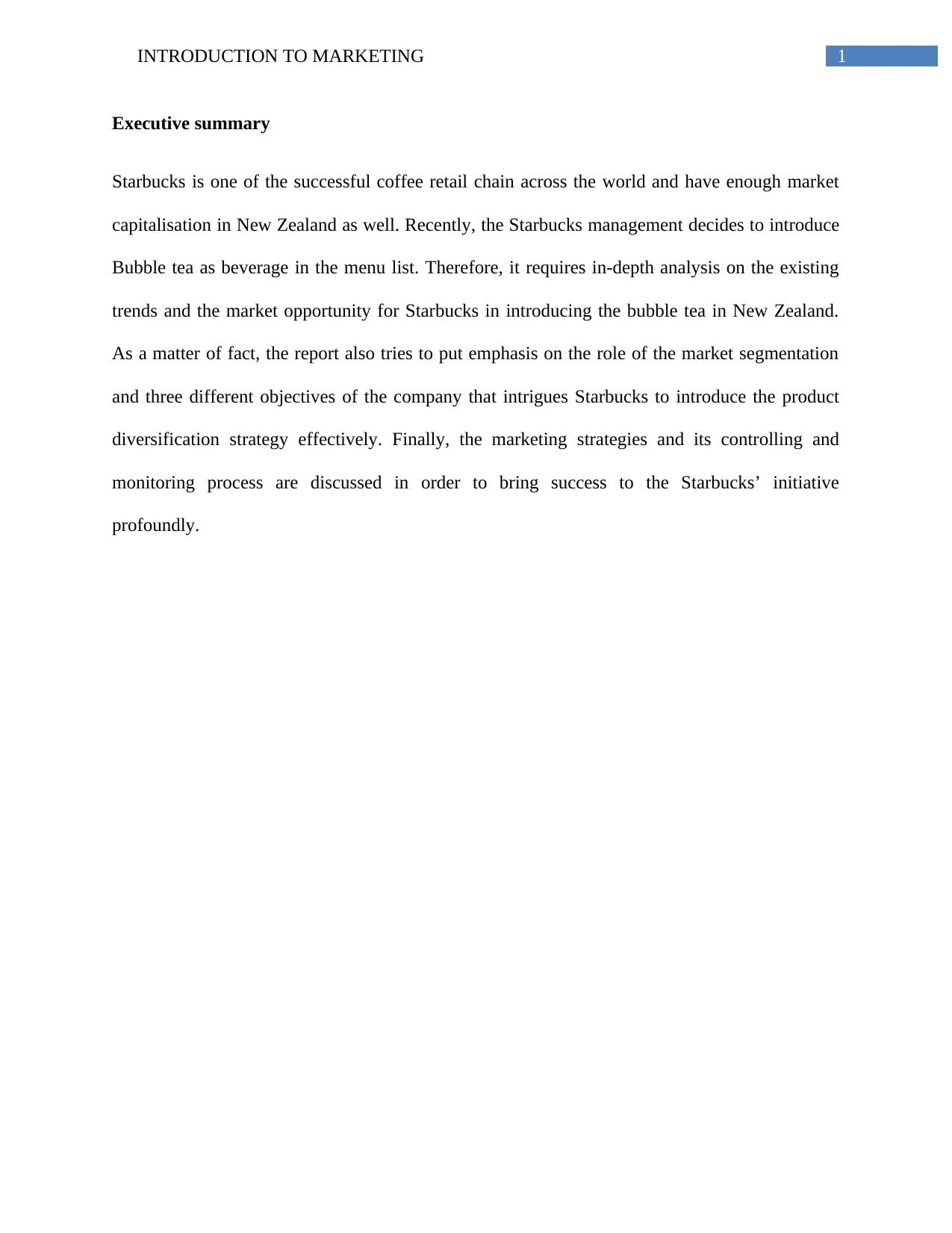
1INTRODUCTION TO MARKETING
Executive summary
Starbucks is one of the successful coffee retail chain across the world and have enough market
capitalisation in New Zealand as well. Recently, the Starbucks management decides to introduce
Bubble tea as beverage in the menu list. Therefore, it requires in-depth analysis on the existing
trends and the market opportunity for Starbucks in introducing the bubble tea in New Zealand.
As a matter of fact, the report also tries to put emphasis on the role of the market segmentation
and three different objectives of the company that intrigues Starbucks to introduce the product
diversification strategy effectively. Finally, the marketing strategies and its controlling and
monitoring process are discussed in order to bring success to the Starbucks’ initiative
profoundly.
Executive summary
Starbucks is one of the successful coffee retail chain across the world and have enough market
capitalisation in New Zealand as well. Recently, the Starbucks management decides to introduce
Bubble tea as beverage in the menu list. Therefore, it requires in-depth analysis on the existing
trends and the market opportunity for Starbucks in introducing the bubble tea in New Zealand.
As a matter of fact, the report also tries to put emphasis on the role of the market segmentation
and three different objectives of the company that intrigues Starbucks to introduce the product
diversification strategy effectively. Finally, the marketing strategies and its controlling and
monitoring process are discussed in order to bring success to the Starbucks’ initiative
profoundly.
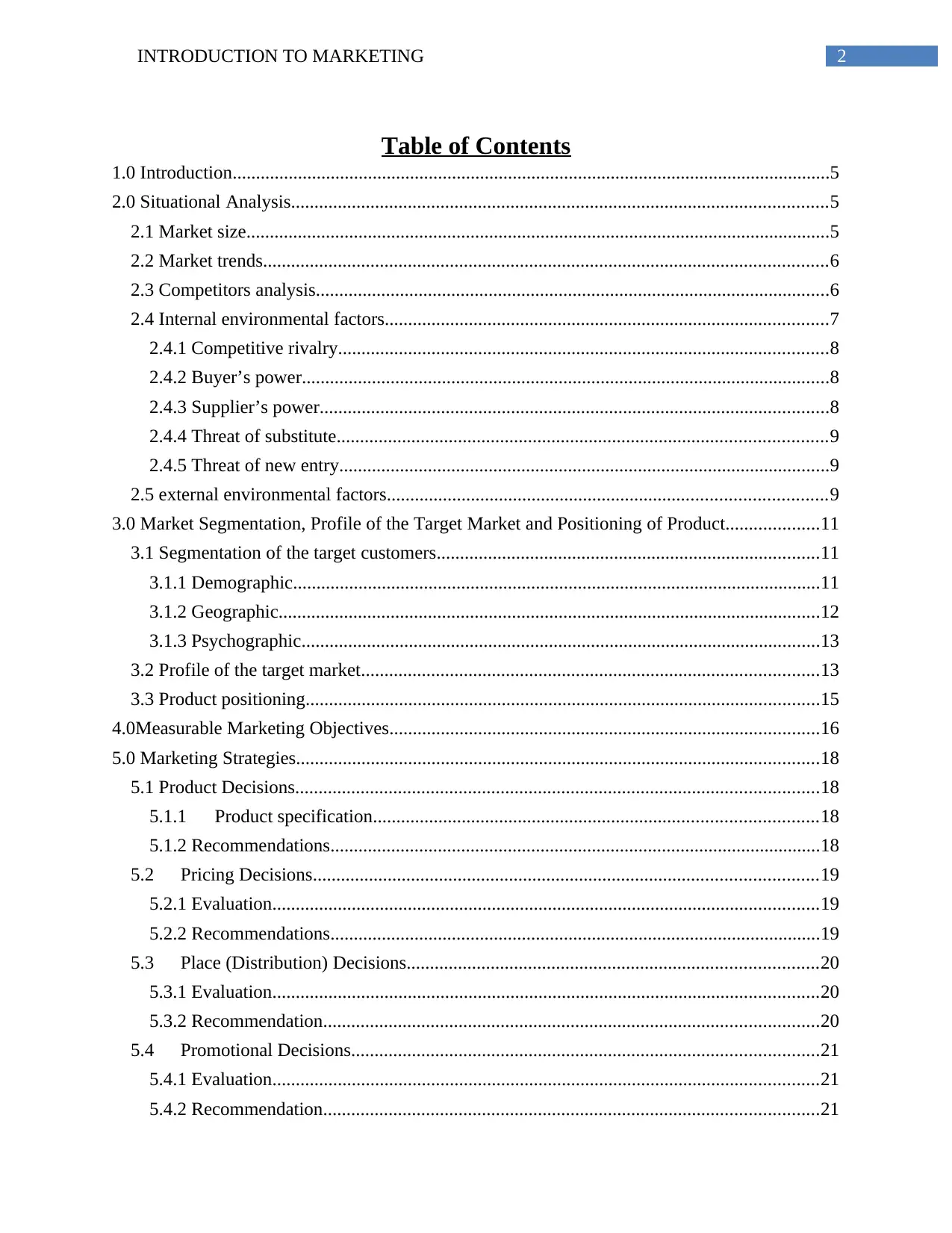
2INTRODUCTION TO MARKETING
Table of Contents
1.0 Introduction................................................................................................................................5
2.0 Situational Analysis...................................................................................................................5
2.1 Market size.............................................................................................................................5
2.2 Market trends.........................................................................................................................6
2.3 Competitors analysis..............................................................................................................6
2.4 Internal environmental factors...............................................................................................7
2.4.1 Competitive rivalry.........................................................................................................8
2.4.2 Buyer’s power.................................................................................................................8
2.4.3 Supplier’s power.............................................................................................................8
2.4.4 Threat of substitute.........................................................................................................9
2.4.5 Threat of new entry.........................................................................................................9
2.5 external environmental factors..............................................................................................9
3.0 Market Segmentation, Profile of the Target Market and Positioning of Product....................11
3.1 Segmentation of the target customers..................................................................................11
3.1.1 Demographic.................................................................................................................11
3.1.2 Geographic....................................................................................................................12
3.1.3 Psychographic...............................................................................................................13
3.2 Profile of the target market..................................................................................................13
3.3 Product positioning..............................................................................................................15
4.0Measurable Marketing Objectives............................................................................................16
5.0 Marketing Strategies................................................................................................................18
5.1 Product Decisions................................................................................................................18
5.1.1 Product specification...............................................................................................18
5.1.2 Recommendations.........................................................................................................18
5.2 Pricing Decisions............................................................................................................19
5.2.1 Evaluation.....................................................................................................................19
5.2.2 Recommendations.........................................................................................................19
5.3 Place (Distribution) Decisions........................................................................................20
5.3.1 Evaluation.....................................................................................................................20
5.3.2 Recommendation..........................................................................................................20
5.4 Promotional Decisions....................................................................................................21
5.4.1 Evaluation.....................................................................................................................21
5.4.2 Recommendation..........................................................................................................21
Table of Contents
1.0 Introduction................................................................................................................................5
2.0 Situational Analysis...................................................................................................................5
2.1 Market size.............................................................................................................................5
2.2 Market trends.........................................................................................................................6
2.3 Competitors analysis..............................................................................................................6
2.4 Internal environmental factors...............................................................................................7
2.4.1 Competitive rivalry.........................................................................................................8
2.4.2 Buyer’s power.................................................................................................................8
2.4.3 Supplier’s power.............................................................................................................8
2.4.4 Threat of substitute.........................................................................................................9
2.4.5 Threat of new entry.........................................................................................................9
2.5 external environmental factors..............................................................................................9
3.0 Market Segmentation, Profile of the Target Market and Positioning of Product....................11
3.1 Segmentation of the target customers..................................................................................11
3.1.1 Demographic.................................................................................................................11
3.1.2 Geographic....................................................................................................................12
3.1.3 Psychographic...............................................................................................................13
3.2 Profile of the target market..................................................................................................13
3.3 Product positioning..............................................................................................................15
4.0Measurable Marketing Objectives............................................................................................16
5.0 Marketing Strategies................................................................................................................18
5.1 Product Decisions................................................................................................................18
5.1.1 Product specification...............................................................................................18
5.1.2 Recommendations.........................................................................................................18
5.2 Pricing Decisions............................................................................................................19
5.2.1 Evaluation.....................................................................................................................19
5.2.2 Recommendations.........................................................................................................19
5.3 Place (Distribution) Decisions........................................................................................20
5.3.1 Evaluation.....................................................................................................................20
5.3.2 Recommendation..........................................................................................................20
5.4 Promotional Decisions....................................................................................................21
5.4.1 Evaluation.....................................................................................................................21
5.4.2 Recommendation..........................................................................................................21
⊘ This is a preview!⊘
Do you want full access?
Subscribe today to unlock all pages.

Trusted by 1+ million students worldwide
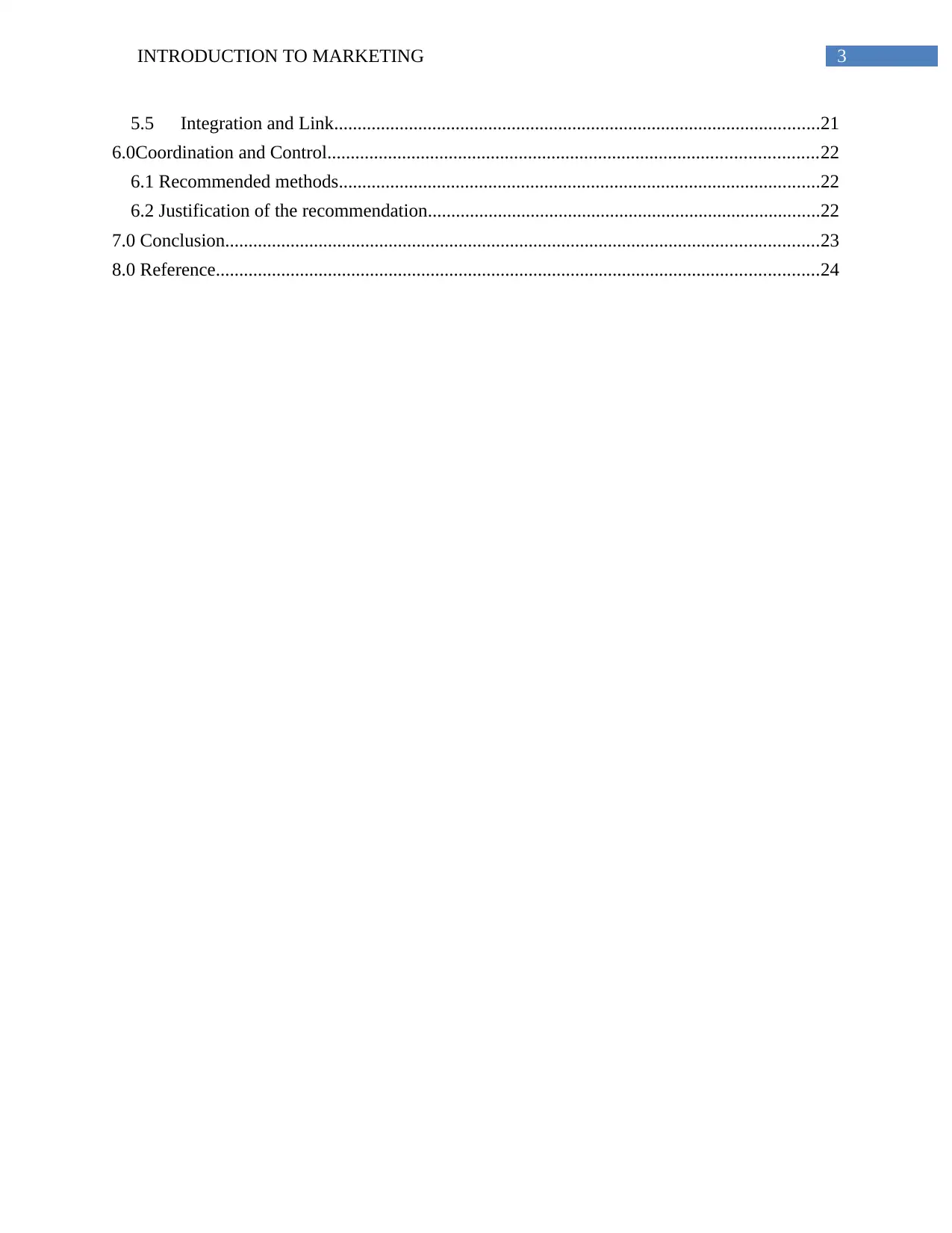
3INTRODUCTION TO MARKETING
5.5 Integration and Link........................................................................................................21
6.0Coordination and Control.........................................................................................................22
6.1 Recommended methods.......................................................................................................22
6.2 Justification of the recommendation....................................................................................22
7.0 Conclusion...............................................................................................................................23
8.0 Reference.................................................................................................................................24
5.5 Integration and Link........................................................................................................21
6.0Coordination and Control.........................................................................................................22
6.1 Recommended methods.......................................................................................................22
6.2 Justification of the recommendation....................................................................................22
7.0 Conclusion...............................................................................................................................23
8.0 Reference.................................................................................................................................24
Paraphrase This Document
Need a fresh take? Get an instant paraphrase of this document with our AI Paraphraser
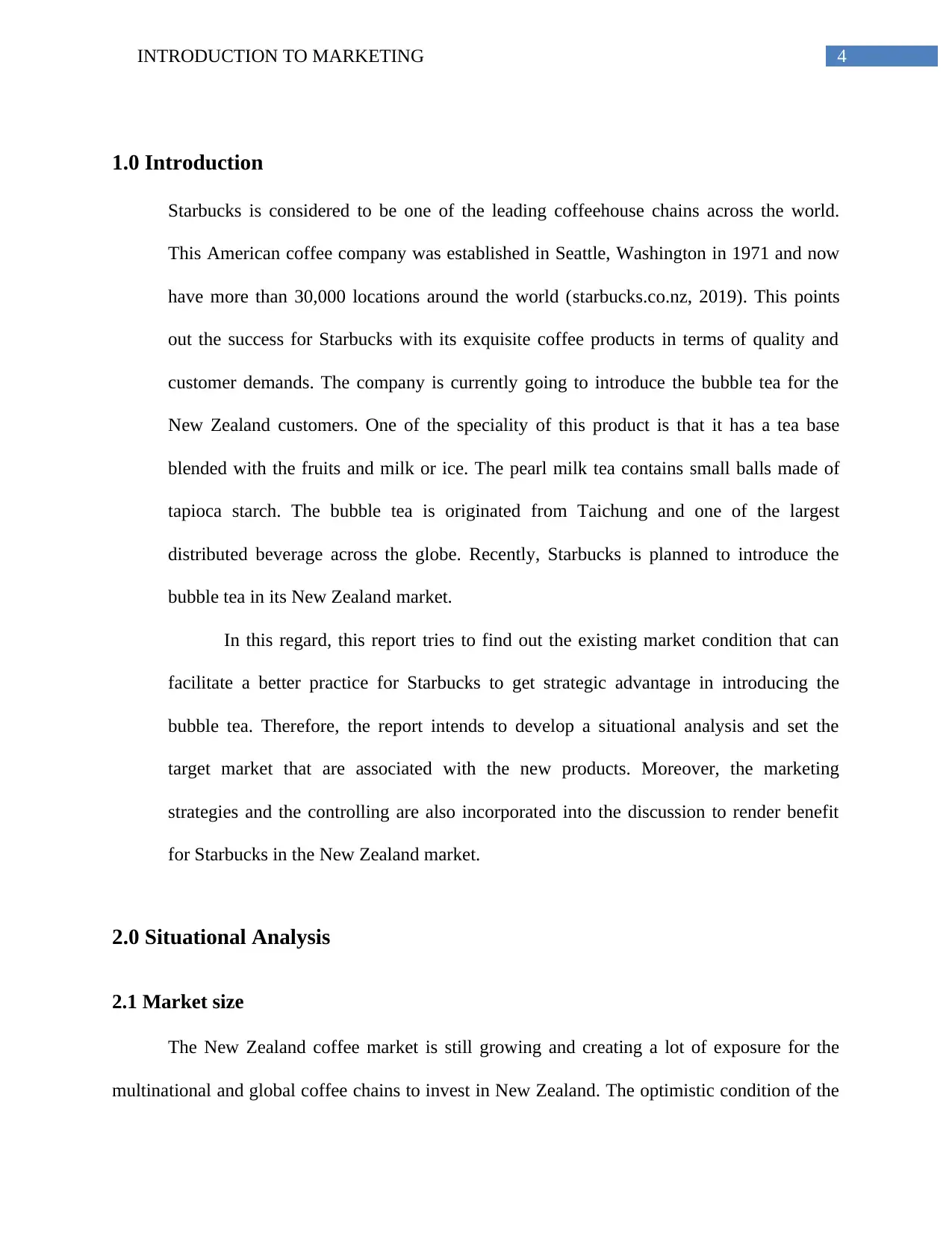
4INTRODUCTION TO MARKETING
1.0 Introduction
Starbucks is considered to be one of the leading coffeehouse chains across the world.
This American coffee company was established in Seattle, Washington in 1971 and now
have more than 30,000 locations around the world (starbucks.co.nz, 2019). This points
out the success for Starbucks with its exquisite coffee products in terms of quality and
customer demands. The company is currently going to introduce the bubble tea for the
New Zealand customers. One of the speciality of this product is that it has a tea base
blended with the fruits and milk or ice. The pearl milk tea contains small balls made of
tapioca starch. The bubble tea is originated from Taichung and one of the largest
distributed beverage across the globe. Recently, Starbucks is planned to introduce the
bubble tea in its New Zealand market.
In this regard, this report tries to find out the existing market condition that can
facilitate a better practice for Starbucks to get strategic advantage in introducing the
bubble tea. Therefore, the report intends to develop a situational analysis and set the
target market that are associated with the new products. Moreover, the marketing
strategies and the controlling are also incorporated into the discussion to render benefit
for Starbucks in the New Zealand market.
2.0 Situational Analysis
2.1 Market size
The New Zealand coffee market is still growing and creating a lot of exposure for the
multinational and global coffee chains to invest in New Zealand. The optimistic condition of the
1.0 Introduction
Starbucks is considered to be one of the leading coffeehouse chains across the world.
This American coffee company was established in Seattle, Washington in 1971 and now
have more than 30,000 locations around the world (starbucks.co.nz, 2019). This points
out the success for Starbucks with its exquisite coffee products in terms of quality and
customer demands. The company is currently going to introduce the bubble tea for the
New Zealand customers. One of the speciality of this product is that it has a tea base
blended with the fruits and milk or ice. The pearl milk tea contains small balls made of
tapioca starch. The bubble tea is originated from Taichung and one of the largest
distributed beverage across the globe. Recently, Starbucks is planned to introduce the
bubble tea in its New Zealand market.
In this regard, this report tries to find out the existing market condition that can
facilitate a better practice for Starbucks to get strategic advantage in introducing the
bubble tea. Therefore, the report intends to develop a situational analysis and set the
target market that are associated with the new products. Moreover, the marketing
strategies and the controlling are also incorporated into the discussion to render benefit
for Starbucks in the New Zealand market.
2.0 Situational Analysis
2.1 Market size
The New Zealand coffee market is still growing and creating a lot of exposure for the
multinational and global coffee chains to invest in New Zealand. The optimistic condition of the
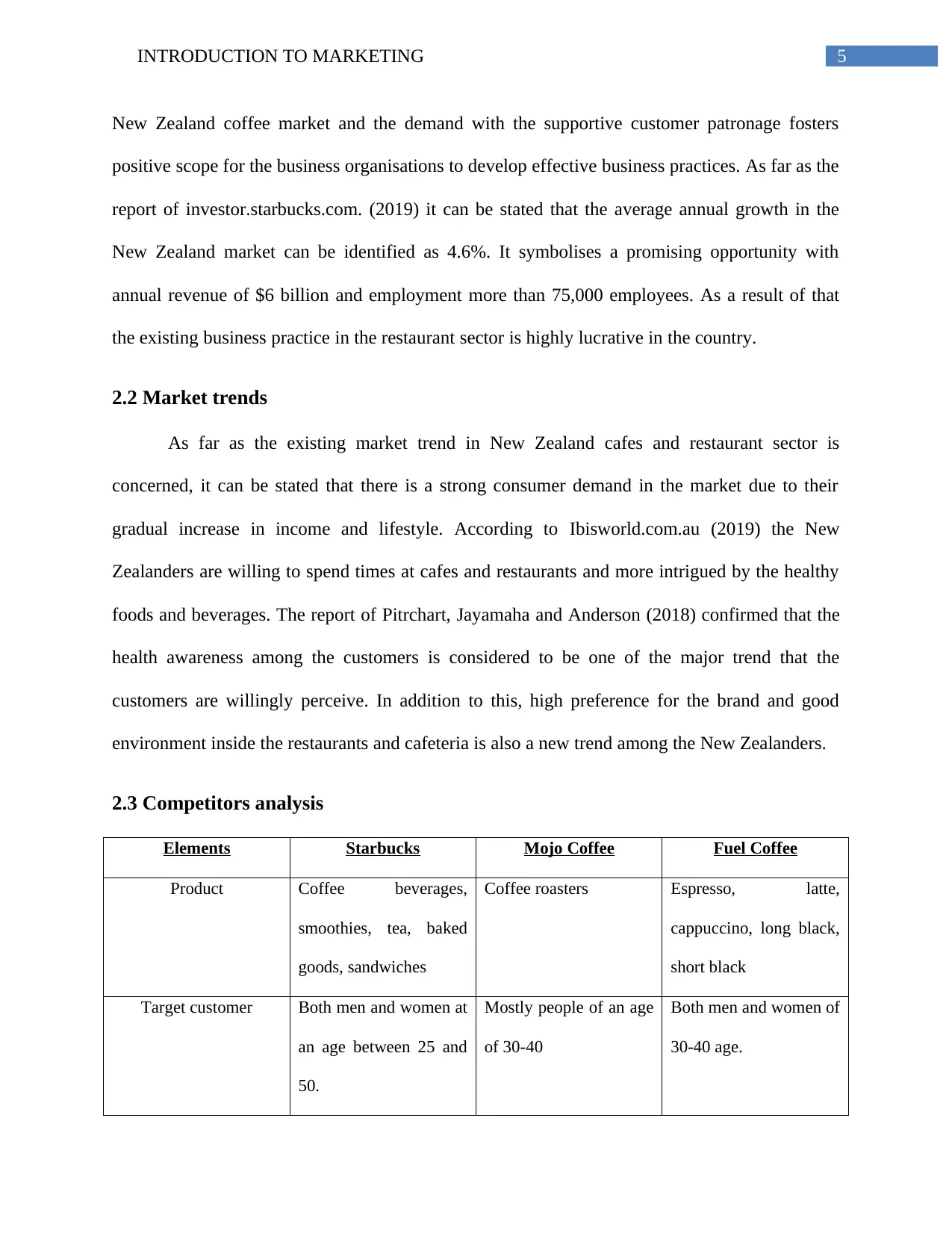
5INTRODUCTION TO MARKETING
New Zealand coffee market and the demand with the supportive customer patronage fosters
positive scope for the business organisations to develop effective business practices. As far as the
report of investor.starbucks.com. (2019) it can be stated that the average annual growth in the
New Zealand market can be identified as 4.6%. It symbolises a promising opportunity with
annual revenue of $6 billion and employment more than 75,000 employees. As a result of that
the existing business practice in the restaurant sector is highly lucrative in the country.
2.2 Market trends
As far as the existing market trend in New Zealand cafes and restaurant sector is
concerned, it can be stated that there is a strong consumer demand in the market due to their
gradual increase in income and lifestyle. According to Ibisworld.com.au (2019) the New
Zealanders are willing to spend times at cafes and restaurants and more intrigued by the healthy
foods and beverages. The report of Pitrchart, Jayamaha and Anderson (2018) confirmed that the
health awareness among the customers is considered to be one of the major trend that the
customers are willingly perceive. In addition to this, high preference for the brand and good
environment inside the restaurants and cafeteria is also a new trend among the New Zealanders.
2.3 Competitors analysis
Elements Starbucks Mojo Coffee Fuel Coffee
Product Coffee beverages,
smoothies, tea, baked
goods, sandwiches
Coffee roasters Espresso, latte,
cappuccino, long black,
short black
Target customer Both men and women at
an age between 25 and
50.
Mostly people of an age
of 30-40
Both men and women of
30-40 age.
New Zealand coffee market and the demand with the supportive customer patronage fosters
positive scope for the business organisations to develop effective business practices. As far as the
report of investor.starbucks.com. (2019) it can be stated that the average annual growth in the
New Zealand market can be identified as 4.6%. It symbolises a promising opportunity with
annual revenue of $6 billion and employment more than 75,000 employees. As a result of that
the existing business practice in the restaurant sector is highly lucrative in the country.
2.2 Market trends
As far as the existing market trend in New Zealand cafes and restaurant sector is
concerned, it can be stated that there is a strong consumer demand in the market due to their
gradual increase in income and lifestyle. According to Ibisworld.com.au (2019) the New
Zealanders are willing to spend times at cafes and restaurants and more intrigued by the healthy
foods and beverages. The report of Pitrchart, Jayamaha and Anderson (2018) confirmed that the
health awareness among the customers is considered to be one of the major trend that the
customers are willingly perceive. In addition to this, high preference for the brand and good
environment inside the restaurants and cafeteria is also a new trend among the New Zealanders.
2.3 Competitors analysis
Elements Starbucks Mojo Coffee Fuel Coffee
Product Coffee beverages,
smoothies, tea, baked
goods, sandwiches
Coffee roasters Espresso, latte,
cappuccino, long black,
short black
Target customer Both men and women at
an age between 25 and
50.
Mostly people of an age
of 30-40
Both men and women of
30-40 age.
⊘ This is a preview!⊘
Do you want full access?
Subscribe today to unlock all pages.

Trusted by 1+ million students worldwide
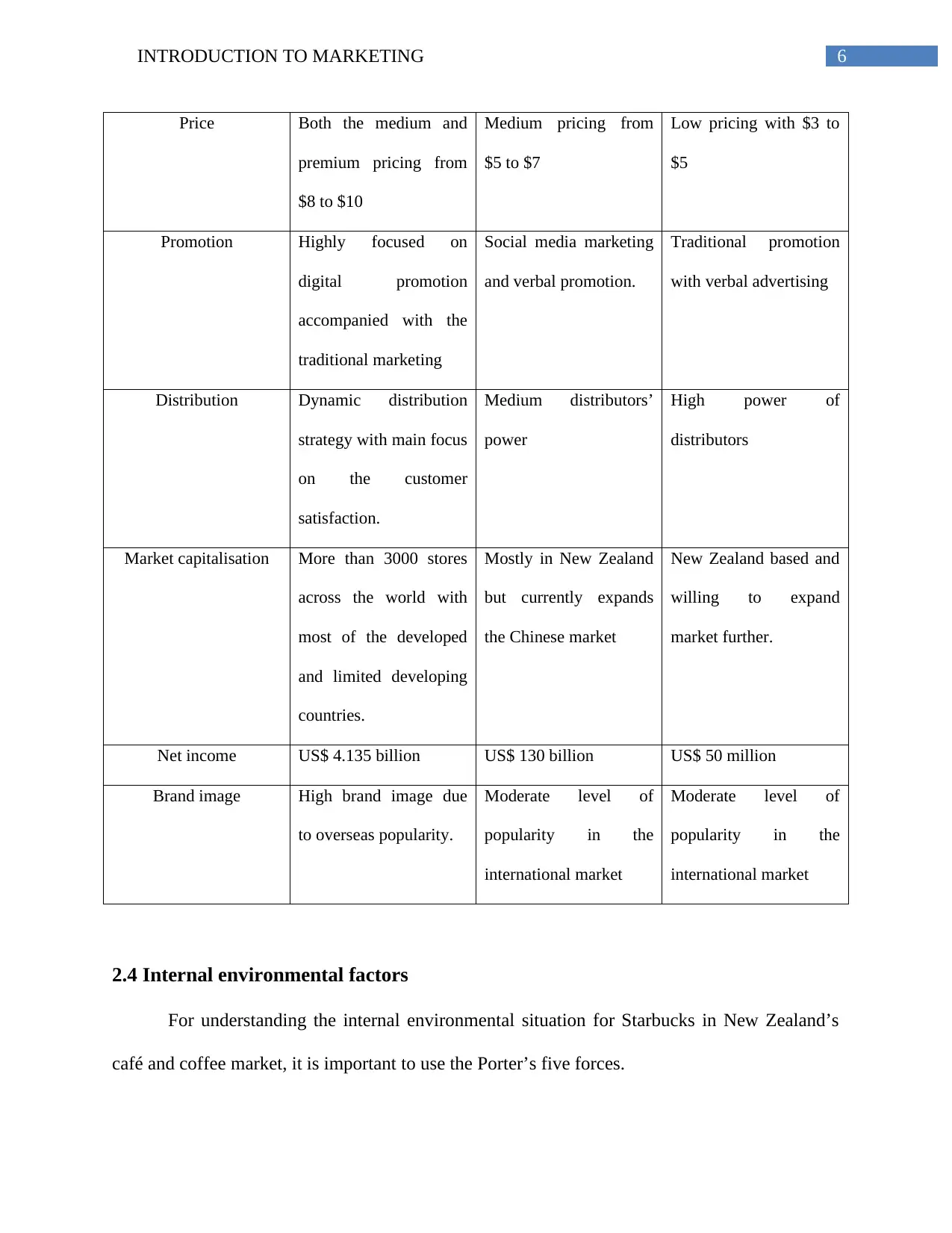
6INTRODUCTION TO MARKETING
Price Both the medium and
premium pricing from
$8 to $10
Medium pricing from
$5 to $7
Low pricing with $3 to
$5
Promotion Highly focused on
digital promotion
accompanied with the
traditional marketing
Social media marketing
and verbal promotion.
Traditional promotion
with verbal advertising
Distribution Dynamic distribution
strategy with main focus
on the customer
satisfaction.
Medium distributors’
power
High power of
distributors
Market capitalisation More than 3000 stores
across the world with
most of the developed
and limited developing
countries.
Mostly in New Zealand
but currently expands
the Chinese market
New Zealand based and
willing to expand
market further.
Net income US$ 4.135 billion US$ 130 billion US$ 50 million
Brand image High brand image due
to overseas popularity.
Moderate level of
popularity in the
international market
Moderate level of
popularity in the
international market
2.4 Internal environmental factors
For understanding the internal environmental situation for Starbucks in New Zealand’s
café and coffee market, it is important to use the Porter’s five forces.
Price Both the medium and
premium pricing from
$8 to $10
Medium pricing from
$5 to $7
Low pricing with $3 to
$5
Promotion Highly focused on
digital promotion
accompanied with the
traditional marketing
Social media marketing
and verbal promotion.
Traditional promotion
with verbal advertising
Distribution Dynamic distribution
strategy with main focus
on the customer
satisfaction.
Medium distributors’
power
High power of
distributors
Market capitalisation More than 3000 stores
across the world with
most of the developed
and limited developing
countries.
Mostly in New Zealand
but currently expands
the Chinese market
New Zealand based and
willing to expand
market further.
Net income US$ 4.135 billion US$ 130 billion US$ 50 million
Brand image High brand image due
to overseas popularity.
Moderate level of
popularity in the
international market
Moderate level of
popularity in the
international market
2.4 Internal environmental factors
For understanding the internal environmental situation for Starbucks in New Zealand’s
café and coffee market, it is important to use the Porter’s five forces.
Paraphrase This Document
Need a fresh take? Get an instant paraphrase of this document with our AI Paraphraser
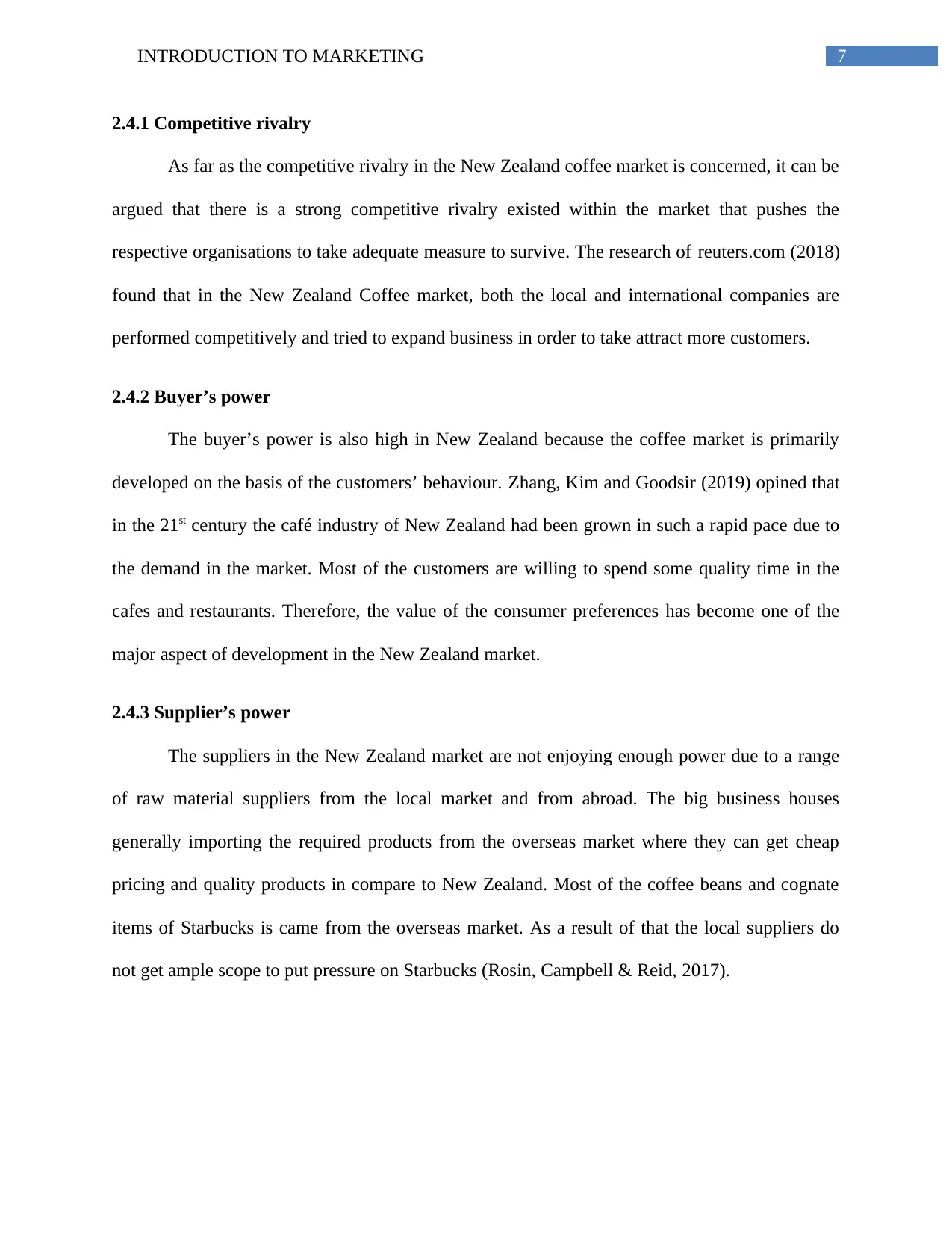
7INTRODUCTION TO MARKETING
2.4.1 Competitive rivalry
As far as the competitive rivalry in the New Zealand coffee market is concerned, it can be
argued that there is a strong competitive rivalry existed within the market that pushes the
respective organisations to take adequate measure to survive. The research of reuters.com (2018)
found that in the New Zealand Coffee market, both the local and international companies are
performed competitively and tried to expand business in order to take attract more customers.
2.4.2 Buyer’s power
The buyer’s power is also high in New Zealand because the coffee market is primarily
developed on the basis of the customers’ behaviour. Zhang, Kim and Goodsir (2019) opined that
in the 21st century the café industry of New Zealand had been grown in such a rapid pace due to
the demand in the market. Most of the customers are willing to spend some quality time in the
cafes and restaurants. Therefore, the value of the consumer preferences has become one of the
major aspect of development in the New Zealand market.
2.4.3 Supplier’s power
The suppliers in the New Zealand market are not enjoying enough power due to a range
of raw material suppliers from the local market and from abroad. The big business houses
generally importing the required products from the overseas market where they can get cheap
pricing and quality products in compare to New Zealand. Most of the coffee beans and cognate
items of Starbucks is came from the overseas market. As a result of that the local suppliers do
not get ample scope to put pressure on Starbucks (Rosin, Campbell & Reid, 2017).
2.4.1 Competitive rivalry
As far as the competitive rivalry in the New Zealand coffee market is concerned, it can be
argued that there is a strong competitive rivalry existed within the market that pushes the
respective organisations to take adequate measure to survive. The research of reuters.com (2018)
found that in the New Zealand Coffee market, both the local and international companies are
performed competitively and tried to expand business in order to take attract more customers.
2.4.2 Buyer’s power
The buyer’s power is also high in New Zealand because the coffee market is primarily
developed on the basis of the customers’ behaviour. Zhang, Kim and Goodsir (2019) opined that
in the 21st century the café industry of New Zealand had been grown in such a rapid pace due to
the demand in the market. Most of the customers are willing to spend some quality time in the
cafes and restaurants. Therefore, the value of the consumer preferences has become one of the
major aspect of development in the New Zealand market.
2.4.3 Supplier’s power
The suppliers in the New Zealand market are not enjoying enough power due to a range
of raw material suppliers from the local market and from abroad. The big business houses
generally importing the required products from the overseas market where they can get cheap
pricing and quality products in compare to New Zealand. Most of the coffee beans and cognate
items of Starbucks is came from the overseas market. As a result of that the local suppliers do
not get ample scope to put pressure on Starbucks (Rosin, Campbell & Reid, 2017).
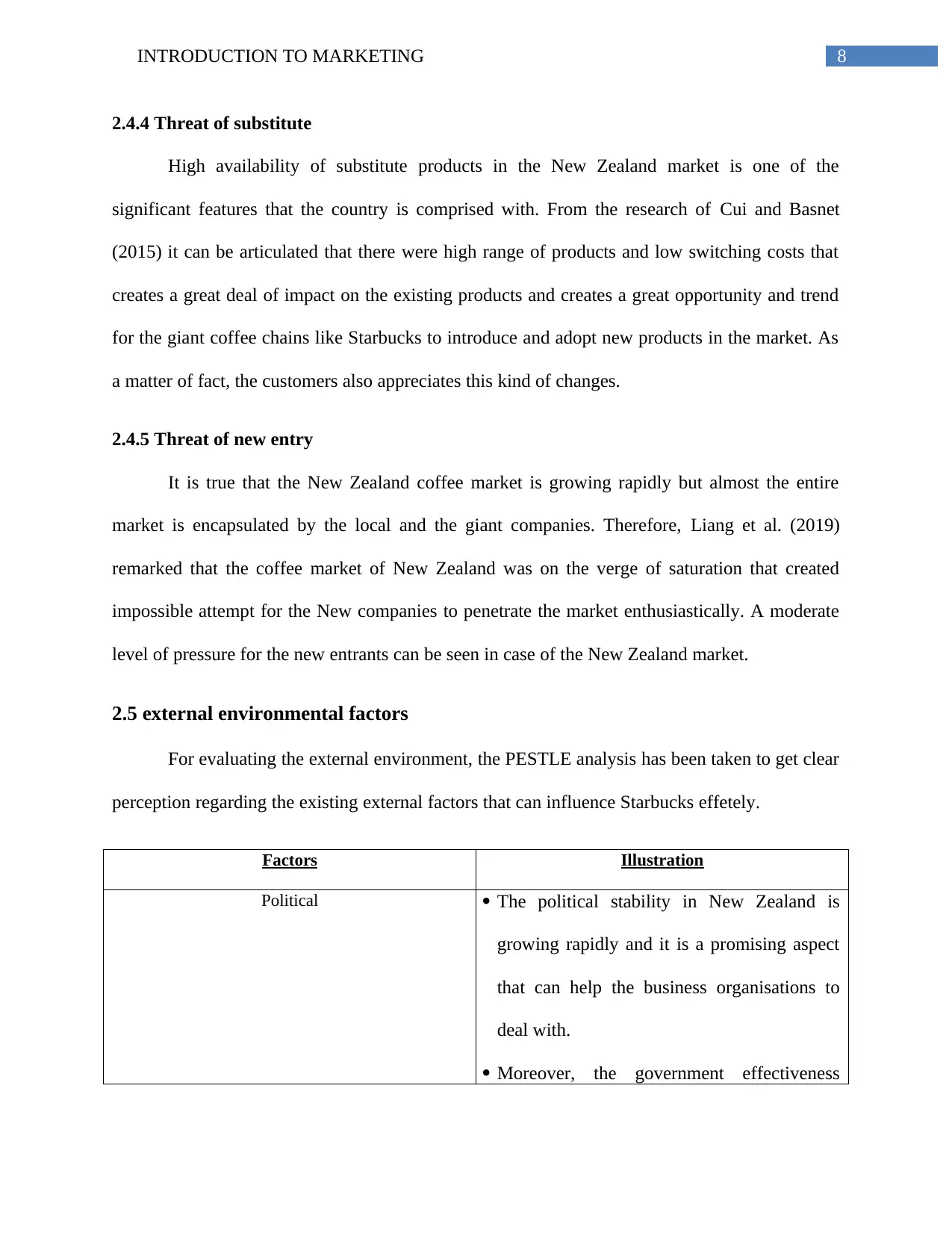
8INTRODUCTION TO MARKETING
2.4.4 Threat of substitute
High availability of substitute products in the New Zealand market is one of the
significant features that the country is comprised with. From the research of Cui and Basnet
(2015) it can be articulated that there were high range of products and low switching costs that
creates a great deal of impact on the existing products and creates a great opportunity and trend
for the giant coffee chains like Starbucks to introduce and adopt new products in the market. As
a matter of fact, the customers also appreciates this kind of changes.
2.4.5 Threat of new entry
It is true that the New Zealand coffee market is growing rapidly but almost the entire
market is encapsulated by the local and the giant companies. Therefore, Liang et al. (2019)
remarked that the coffee market of New Zealand was on the verge of saturation that created
impossible attempt for the New companies to penetrate the market enthusiastically. A moderate
level of pressure for the new entrants can be seen in case of the New Zealand market.
2.5 external environmental factors
For evaluating the external environment, the PESTLE analysis has been taken to get clear
perception regarding the existing external factors that can influence Starbucks effetely.
Factors Illustration
Political The political stability in New Zealand is
growing rapidly and it is a promising aspect
that can help the business organisations to
deal with.
Moreover, the government effectiveness
2.4.4 Threat of substitute
High availability of substitute products in the New Zealand market is one of the
significant features that the country is comprised with. From the research of Cui and Basnet
(2015) it can be articulated that there were high range of products and low switching costs that
creates a great deal of impact on the existing products and creates a great opportunity and trend
for the giant coffee chains like Starbucks to introduce and adopt new products in the market. As
a matter of fact, the customers also appreciates this kind of changes.
2.4.5 Threat of new entry
It is true that the New Zealand coffee market is growing rapidly but almost the entire
market is encapsulated by the local and the giant companies. Therefore, Liang et al. (2019)
remarked that the coffee market of New Zealand was on the verge of saturation that created
impossible attempt for the New companies to penetrate the market enthusiastically. A moderate
level of pressure for the new entrants can be seen in case of the New Zealand market.
2.5 external environmental factors
For evaluating the external environment, the PESTLE analysis has been taken to get clear
perception regarding the existing external factors that can influence Starbucks effetely.
Factors Illustration
Political The political stability in New Zealand is
growing rapidly and it is a promising aspect
that can help the business organisations to
deal with.
Moreover, the government effectiveness
⊘ This is a preview!⊘
Do you want full access?
Subscribe today to unlock all pages.

Trusted by 1+ million students worldwide
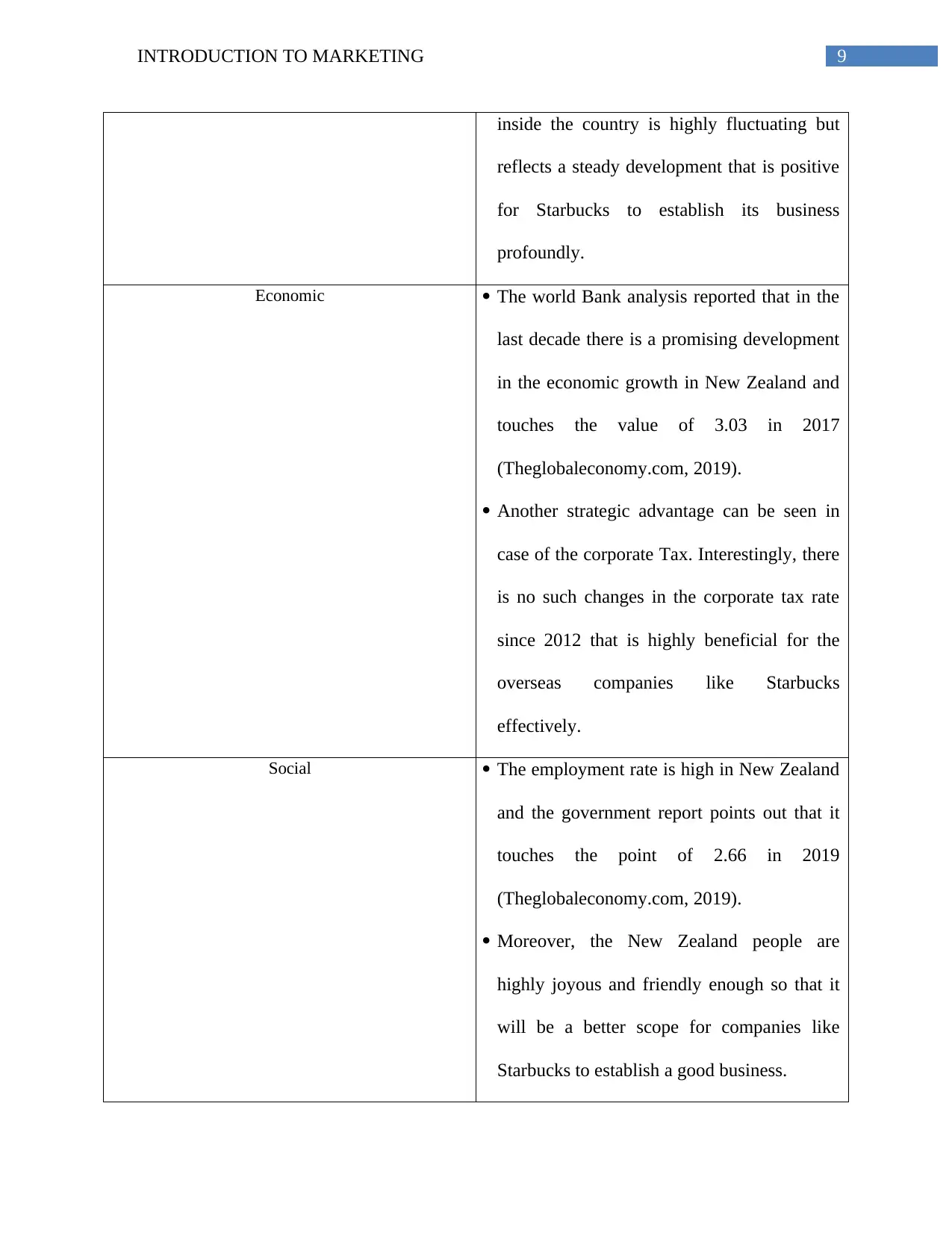
9INTRODUCTION TO MARKETING
inside the country is highly fluctuating but
reflects a steady development that is positive
for Starbucks to establish its business
profoundly.
Economic The world Bank analysis reported that in the
last decade there is a promising development
in the economic growth in New Zealand and
touches the value of 3.03 in 2017
(Theglobaleconomy.com, 2019).
Another strategic advantage can be seen in
case of the corporate Tax. Interestingly, there
is no such changes in the corporate tax rate
since 2012 that is highly beneficial for the
overseas companies like Starbucks
effectively.
Social The employment rate is high in New Zealand
and the government report points out that it
touches the point of 2.66 in 2019
(Theglobaleconomy.com, 2019).
Moreover, the New Zealand people are
highly joyous and friendly enough so that it
will be a better scope for companies like
Starbucks to establish a good business.
inside the country is highly fluctuating but
reflects a steady development that is positive
for Starbucks to establish its business
profoundly.
Economic The world Bank analysis reported that in the
last decade there is a promising development
in the economic growth in New Zealand and
touches the value of 3.03 in 2017
(Theglobaleconomy.com, 2019).
Another strategic advantage can be seen in
case of the corporate Tax. Interestingly, there
is no such changes in the corporate tax rate
since 2012 that is highly beneficial for the
overseas companies like Starbucks
effectively.
Social The employment rate is high in New Zealand
and the government report points out that it
touches the point of 2.66 in 2019
(Theglobaleconomy.com, 2019).
Moreover, the New Zealand people are
highly joyous and friendly enough so that it
will be a better scope for companies like
Starbucks to establish a good business.
Paraphrase This Document
Need a fresh take? Get an instant paraphrase of this document with our AI Paraphraser
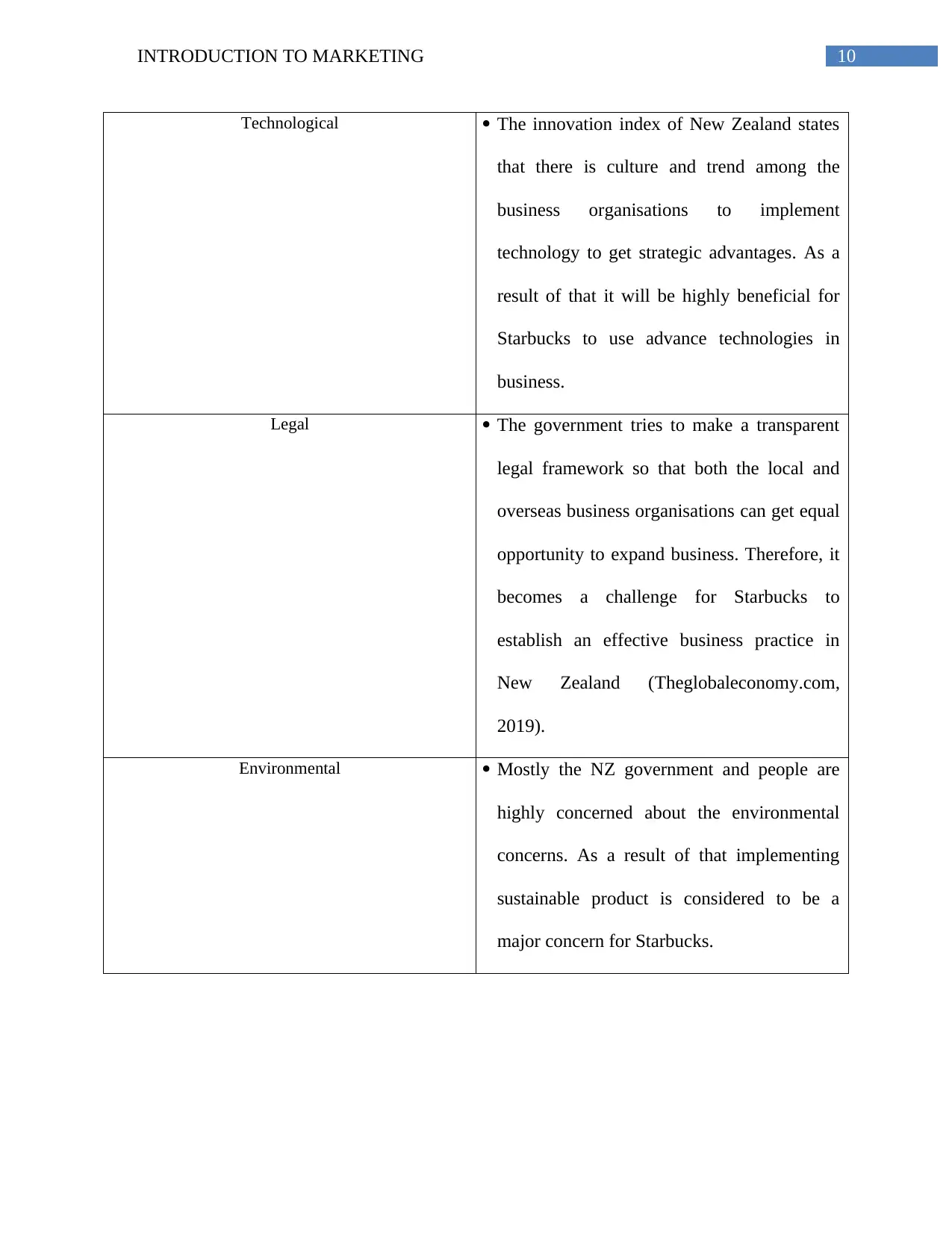
10INTRODUCTION TO MARKETING
Technological The innovation index of New Zealand states
that there is culture and trend among the
business organisations to implement
technology to get strategic advantages. As a
result of that it will be highly beneficial for
Starbucks to use advance technologies in
business.
Legal The government tries to make a transparent
legal framework so that both the local and
overseas business organisations can get equal
opportunity to expand business. Therefore, it
becomes a challenge for Starbucks to
establish an effective business practice in
New Zealand (Theglobaleconomy.com,
2019).
Environmental Mostly the NZ government and people are
highly concerned about the environmental
concerns. As a result of that implementing
sustainable product is considered to be a
major concern for Starbucks.
Technological The innovation index of New Zealand states
that there is culture and trend among the
business organisations to implement
technology to get strategic advantages. As a
result of that it will be highly beneficial for
Starbucks to use advance technologies in
business.
Legal The government tries to make a transparent
legal framework so that both the local and
overseas business organisations can get equal
opportunity to expand business. Therefore, it
becomes a challenge for Starbucks to
establish an effective business practice in
New Zealand (Theglobaleconomy.com,
2019).
Environmental Mostly the NZ government and people are
highly concerned about the environmental
concerns. As a result of that implementing
sustainable product is considered to be a
major concern for Starbucks.
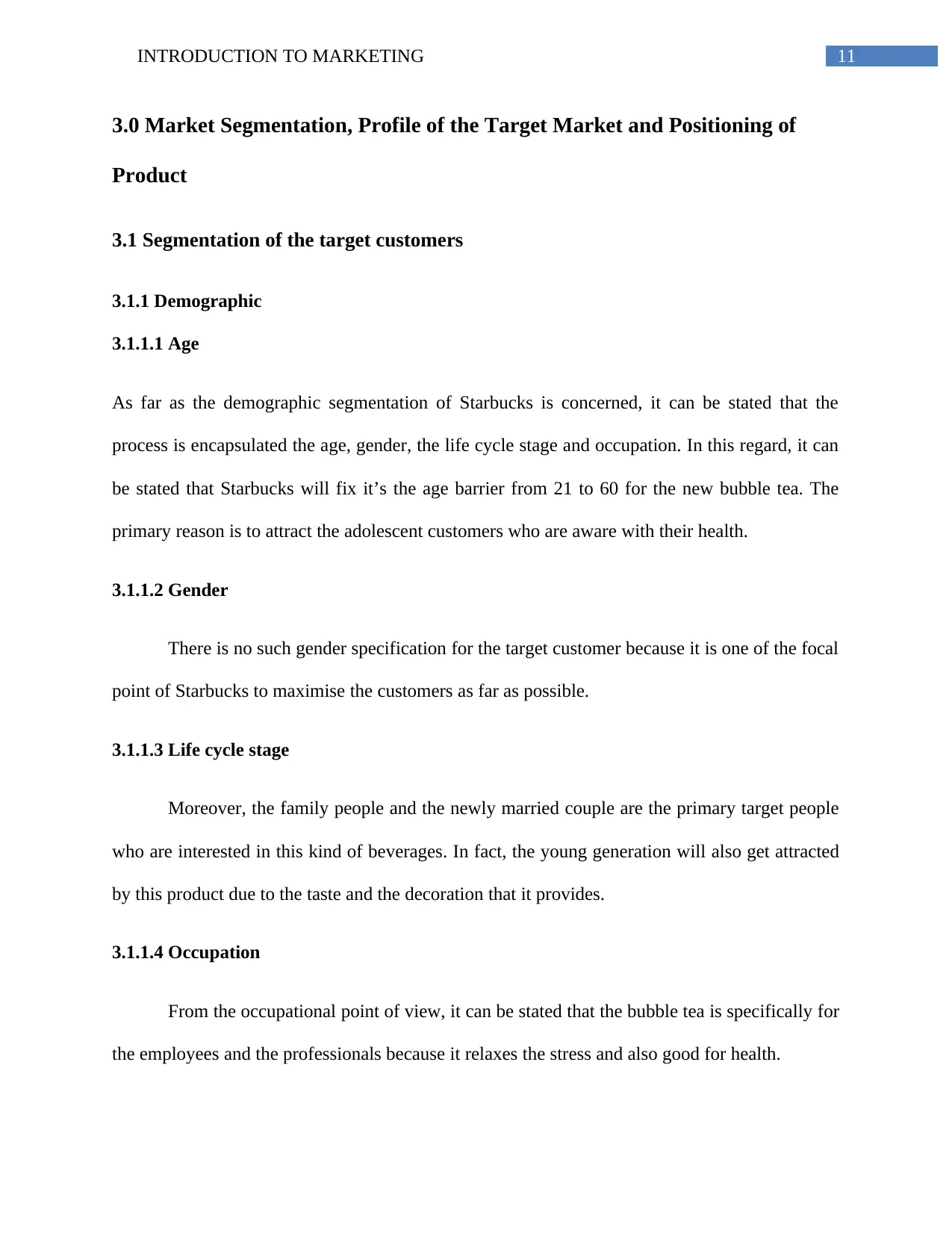
11INTRODUCTION TO MARKETING
3.0 Market Segmentation, Profile of the Target Market and Positioning of
Product
3.1 Segmentation of the target customers
3.1.1 Demographic
3.1.1.1 Age
As far as the demographic segmentation of Starbucks is concerned, it can be stated that the
process is encapsulated the age, gender, the life cycle stage and occupation. In this regard, it can
be stated that Starbucks will fix it’s the age barrier from 21 to 60 for the new bubble tea. The
primary reason is to attract the adolescent customers who are aware with their health.
3.1.1.2 Gender
There is no such gender specification for the target customer because it is one of the focal
point of Starbucks to maximise the customers as far as possible.
3.1.1.3 Life cycle stage
Moreover, the family people and the newly married couple are the primary target people
who are interested in this kind of beverages. In fact, the young generation will also get attracted
by this product due to the taste and the decoration that it provides.
3.1.1.4 Occupation
From the occupational point of view, it can be stated that the bubble tea is specifically for
the employees and the professionals because it relaxes the stress and also good for health.
3.0 Market Segmentation, Profile of the Target Market and Positioning of
Product
3.1 Segmentation of the target customers
3.1.1 Demographic
3.1.1.1 Age
As far as the demographic segmentation of Starbucks is concerned, it can be stated that the
process is encapsulated the age, gender, the life cycle stage and occupation. In this regard, it can
be stated that Starbucks will fix it’s the age barrier from 21 to 60 for the new bubble tea. The
primary reason is to attract the adolescent customers who are aware with their health.
3.1.1.2 Gender
There is no such gender specification for the target customer because it is one of the focal
point of Starbucks to maximise the customers as far as possible.
3.1.1.3 Life cycle stage
Moreover, the family people and the newly married couple are the primary target people
who are interested in this kind of beverages. In fact, the young generation will also get attracted
by this product due to the taste and the decoration that it provides.
3.1.1.4 Occupation
From the occupational point of view, it can be stated that the bubble tea is specifically for
the employees and the professionals because it relaxes the stress and also good for health.
⊘ This is a preview!⊘
Do you want full access?
Subscribe today to unlock all pages.

Trusted by 1+ million students worldwide
1 out of 26
Related Documents
Your All-in-One AI-Powered Toolkit for Academic Success.
+13062052269
info@desklib.com
Available 24*7 on WhatsApp / Email
![[object Object]](/_next/static/media/star-bottom.7253800d.svg)
Unlock your academic potential
Copyright © 2020–2025 A2Z Services. All Rights Reserved. Developed and managed by ZUCOL.





